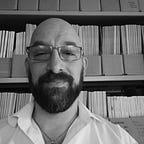The weavers of memories (05)
III. The why of things. The reasons behind the shuttle (and B)
[This post is the fifth of a series in which I will share a text entitled Los tejedores de memorias (“The weavers of memories”), which I produced as the final work for my master’s degree in Historical Archives and Memory at the Pontificia Universidad Javeriana in Bogota (Colombia). All posts can be viewed on my website, while the original text, complete with quotes and notes, can be downloaded here].
The brief review of concepts and ideas developed up to this point (and shared in the previous 4 parts of this series) suggests a relative disconnection between memory — understood as a fabric — and the archive — as a space of memories — on the one hand, and the natural sciences on the other. This disconnection leads to missed opportunities for the use of valuable documents and the construction of scientific narratives other than the usual ones, which complement or even challenge and contradict them.
Based on this problem, the following research question is posed, around which this text is structured: what role can natural science archives play in the recovery and management of memory, especially in terms of the construction of other discourses and other possible histories?
An exercise of theoretical review, documentary analysis and critical reflection, such as the one we intend to carry out throughout these pages, can present the archive as something different from the stereotypical passive and silent warehouse: a living place, capable of selecting documents, recovering memories, and suggesting and proposing possible connections and, with that, possible paths and narratives. It can show that an archive is capable of selecting which stories are told, why and from which perspectives; of offering a reflexive and critical curatorship; of proposing connections and actively constructing discourse, from a non-neutral and compromised position. An archive, in short, capable of being a true weaver of memories.
It can reveal that in a single document an infinite number of stories, tales, knowledge, and memories converge, and that from the archive it is possible to recover, organize and make visible all the strands that make up that fabric. Strands that describe a past and a path, and that at the same time may be pointing out paths and possibilities for the future.
Finally, it can demonstrate that, through such a weaving of memories, it is possible to generate other discourses and other possible stories in the field of natural sciences from the archive. Stories that make it possible to analyze an event or understand a phenomenon from other points of view, with the subsequent production of new ideas, research perspectives and work possibilities.
Exploring the roles that archiving can play in the natural sciences can open up a wide range of possibilities for professionals in this disciplinary field; possibilities that can be extrapolated to other areas of knowledge, including critical and innovative options.
It can also place memory as an essential element in the construction of discourses, stories and knowledge related to science and its historical, socio-political and cultural context.
And it can strip the archive of the halo of “passive depository of old documents” that it retains among the sciences, and turn it into its best ally when it comes to weaving and presenting memories, and producing other stories from them.
In order to develop this exercise, the ideas put forward by critical archival science are presented as a necessary starting point. Specifically, those used by the so-called “rogue archival science”.
[To be continued…]
